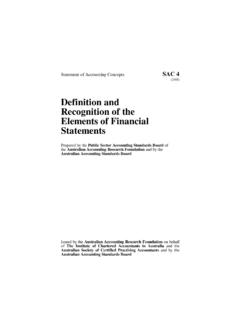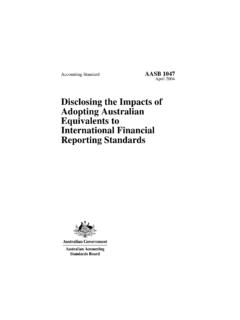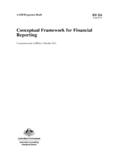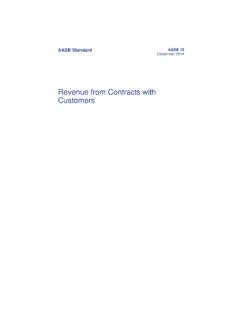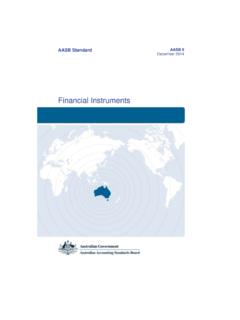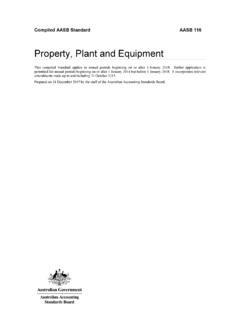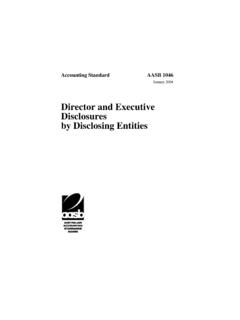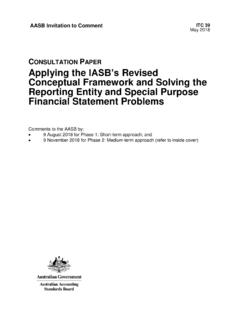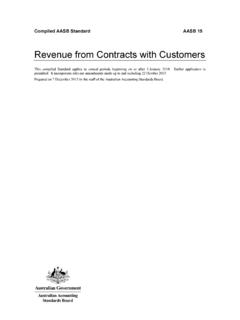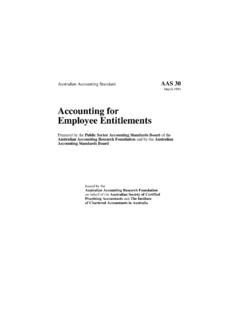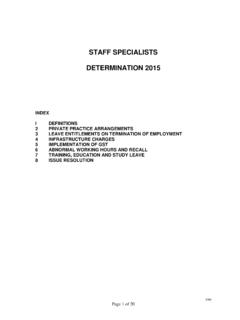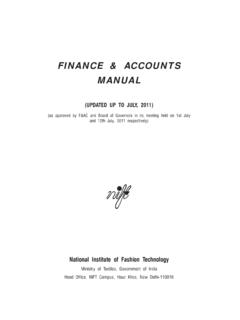Transcription of Related Party Disclosures
1 AASB Standard AASB 124. July 2015. Related Party Disclosures Federal Register of Legislative Instruments F2015L01621. Obtaining a copy of this accounting Standard This Standard is available on the AASB website: Australian accounting Standards Board PO Box 204. Collins Street West Victoria 8007. AUSTRALIA. Phone: (03) 9617 7637. E-mail: Website: Other enquiries Phone: (03) 9617 7600. E-mail: COPYRIGHT. Commonwealth of Australia 2015. This AASB Standard contains IFRS Foundation copyright material. Reproduction within Australia in unaltered form (retaining this notice) is permitted for personal and non-commercial use subject to the inclusion of an acknowledgment of the source.
2 Requests and enquiries concerning reproduction and rights for commercial purposes within Australia should be addressed to The Director of Finance and Administration, Australian accounting Standards Board, PO Box 204, Collins Street West, Victoria 8007. All existing rights in this material are reserved outside Australia. Reproduction outside Australia in unaltered form (retaining this notice) is permitted for personal and non-commercial use only. Further information and requests for authorisation to reproduce for commercial purposes outside Australia should be addressed to the IFRS Foundation at ISSN 1036-4803. AASB 124 2 COPYRIGHT. Federal Register of Legislative Instruments F2015L01621.
3 Contents COMPARISON WITH IAS 24. accounting STANDARD. AASB 124 Related Party Disclosures . from paragraph OBJECTIVE 1. SCOPE 2. PURPOSE OF Related Party Disclosures 5. DEFINITIONS 9. Disclosures . All entities 13. Government- Related entities 25. EFFECTIVE DATE AND TRANSITION 28. WITHDRAWAL OF IAS 24 (2003) 29. COMMENCEMENT OF THE LEGISLATIVE INSTRUMENT WITHDRAWAL OF AASB PRONOUNCEMENTS APPENDICES. A Australian defined terms B Australian reduced disclosure requirements AUSTRALIAN IMPLEMENTATION GUIDANCE FOR NOT-FOR-PROFIT PUBLIC. SECTOR ENTITIES. ILLUSTRATIVE EXAMPLES. DELETED IAS 24 TEXT. BASIS FOR CONCLUSIONS ON AASB 2015-6. AVAILABLE ON THE AASB WEBSITE.
4 Basis for Conclusions on IAS 24. Australian accounting Standard AASB 124 Related Party Disclosures is set out in paragraphs 1 and Appendices A B and the Australian Implementation Guidance. All the paragraphs have equal authority. Paragraphs in bold type state the main principles. AASB 124 is to be read in the context of other Australian accounting Standards, including AASB 1048 Interpretation of Standards, which identifies the Australian accounting Interpretations, and AASB 1057 Application of Australian accounting Standards. In the absence of explicit guidance, AASB 108 accounting Policies, Changes in accounting Estimates and Errors provides a basis for selecting and applying accounting policies.
5 AASB 124 3 CONTENTS. Federal Register of Legislative Instruments F2015L01621. Comparison with IAS 24. AASB 124 Related Party Disclosures incorporates IAS 24 Related Party Disclosures issued by the International accounting Standards Board (IASB). Australian-specific paragraphs (which are not included in IAS 24) are identified with the prefix Aus . Paragraphs that apply only to not-for-profit entities begin by identifying their limited applicability. Tier 1. For-profit entities complying with AASB 124 also comply with IAS 24. Not-for-profit entities' compliance with IAS 24 will depend on whether any Aus paragraphs that specifically apply to not-for-profit entities provide additional guidance or contain applicable requirements that are inconsistent with IAS 24.
6 Tier 2. Entities preparing general purpose financial statements under Australian accounting Standards Reduced Disclosure Requirements (Tier 2) will not be in compliance with IFRSs. AASB 1053 Application of Tiers of Australian accounting Standards explains the two tiers of reporting requirements. AASB 124 4 COMPARISON. Federal Register of Legislative Instruments F2015L01621. accounting Standard AASB 124. The Australian accounting Standards Board makes accounting Standard AASB 124 Related Party Disclosures under section 334 of the Corporations Act 2001. Kris Peach Dated 24 July 2015 Chair AASB. accounting Standard AASB 124. Related Party Disclosures Objective 1 The objective of this Standard is to ensure that an entity's financial statements contain the Disclosures necessary to draw attention to the possibility that its financial position and profit or loss may have been affected by the existence of Related parties and by transactions and outstanding balances, including commitments, with such parties.
7 Scope 2 This Standard shall be applied in: (a) identifying Related Party relationships and transactions;. (b) identifying outstanding balances, including commitments, between an entity and its Related parties;. (c) identifying the circumstances in which disclosure of the items in (a) and (b) is required; and (d) determining the Disclosures to be made about those items. 3 This Standard requires disclosure of Related Party relationships, transactions and outstanding balances, including commitments, in the consolidated and separate financial statements of a parent or investors with joint control of, or significant influence over, an investee presented in accordance with AASB 10 Consolidated Financial Statements or AASB 127 Separate Financial Statements.
8 This Standard also applies to individual financial statements. 4 Related Party transactions and outstanding balances with other entities in a group are disclosed in an entity's financial statements. Intragroup Related Party transactions and outstanding balances are eliminated, except for those between an investment entity and its subsidiaries measured at fair value through profit or loss, in the preparation of consolidated financial statements of the group. Purpose of Related Party Disclosures 5 Related Party relationships are a normal feature of commerce and business. For example, entities frequently carry on parts of their activities through subsidiaries, joint ventures and associates.
9 In those circumstances, the entity has the ability to affect the financial and operating policies of the investee through the presence of control, joint control or significant influence. 6 A Related Party relationship could have an effect on the profit or loss and financial position of an entity. Related parties may enter into transactions that unrelated parties would not. For example, an entity that sells goods to its parent at cost might not sell on those terms to another customer. Also, transactions between Related parties may not be made at the same amounts as between unrelated parties. 7 The profit or loss and financial position of an entity may be affected by a Related Party relationship even if Related Party transactions do not occur.
10 The mere existence of the relationship may be sufficient to affect the transactions of the entity with other parties. For example, a subsidiary may terminate relations with a trading partner on acquisition by the parent of a fellow subsidiary engaged in the same activity as the former trading partner. Alternatively, one Party may refrain from acting because of the significant influence of another for example, a subsidiary may be instructed by its parent not to engage in research and development. AASB 124 5 STANDARD. Federal Register of Legislative Instruments F2015L01621. 8 For these reasons, knowledge of an entity's transactions, outstanding balances, including commitments, and relationships with Related parties may affect assessments of its operations by users of financial statements, including assessments of the risks and opportunities facing the entity.
